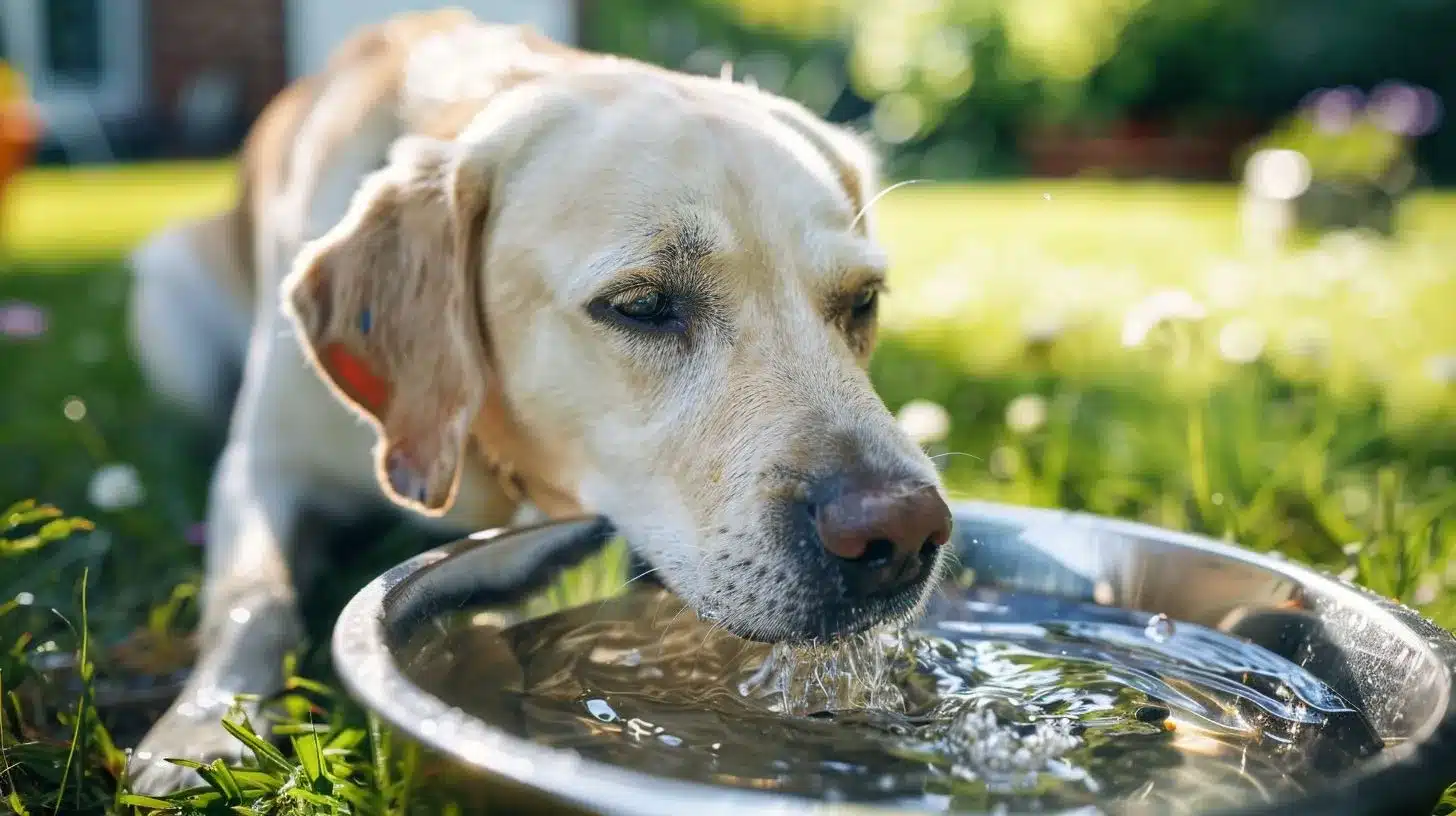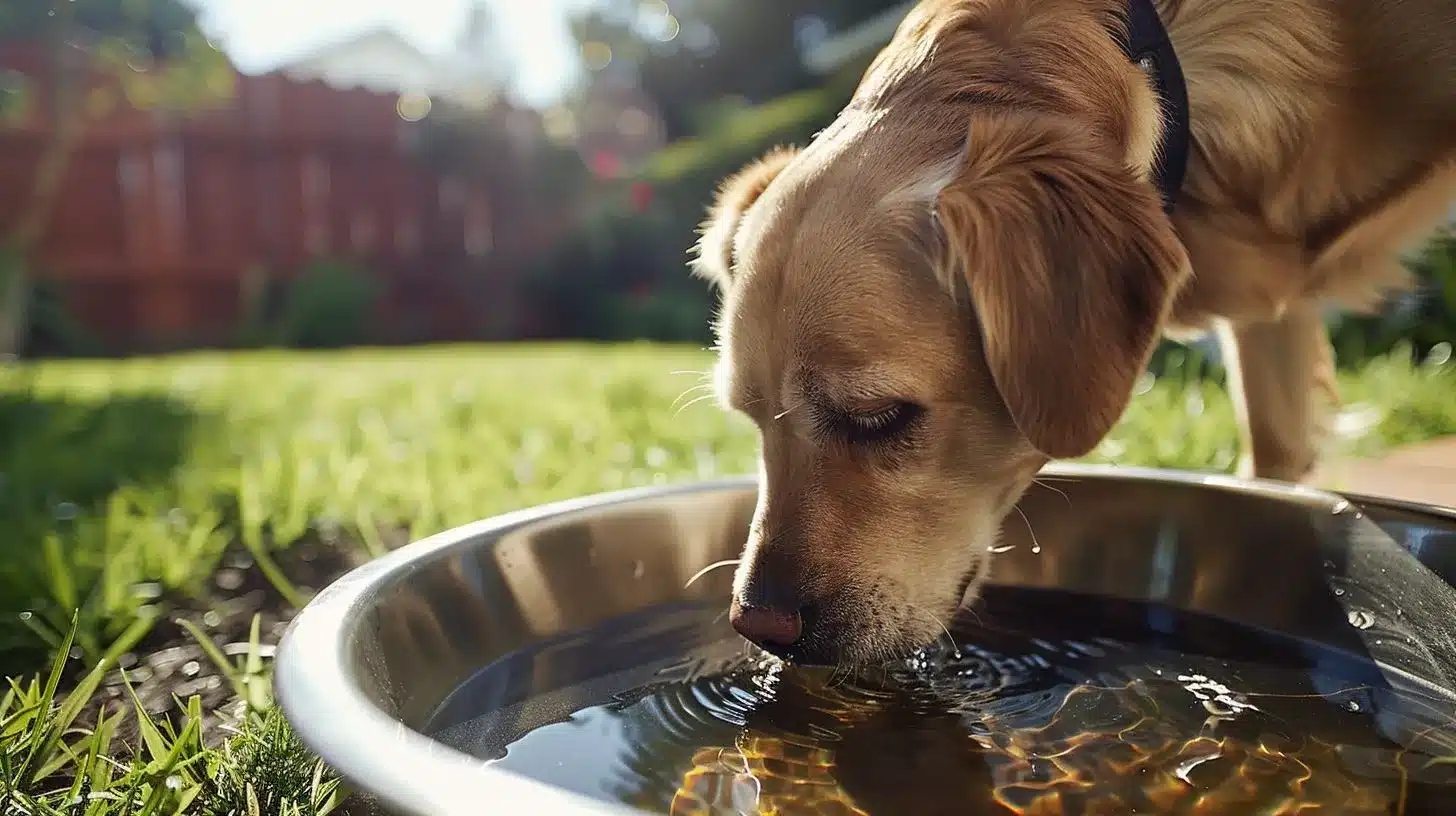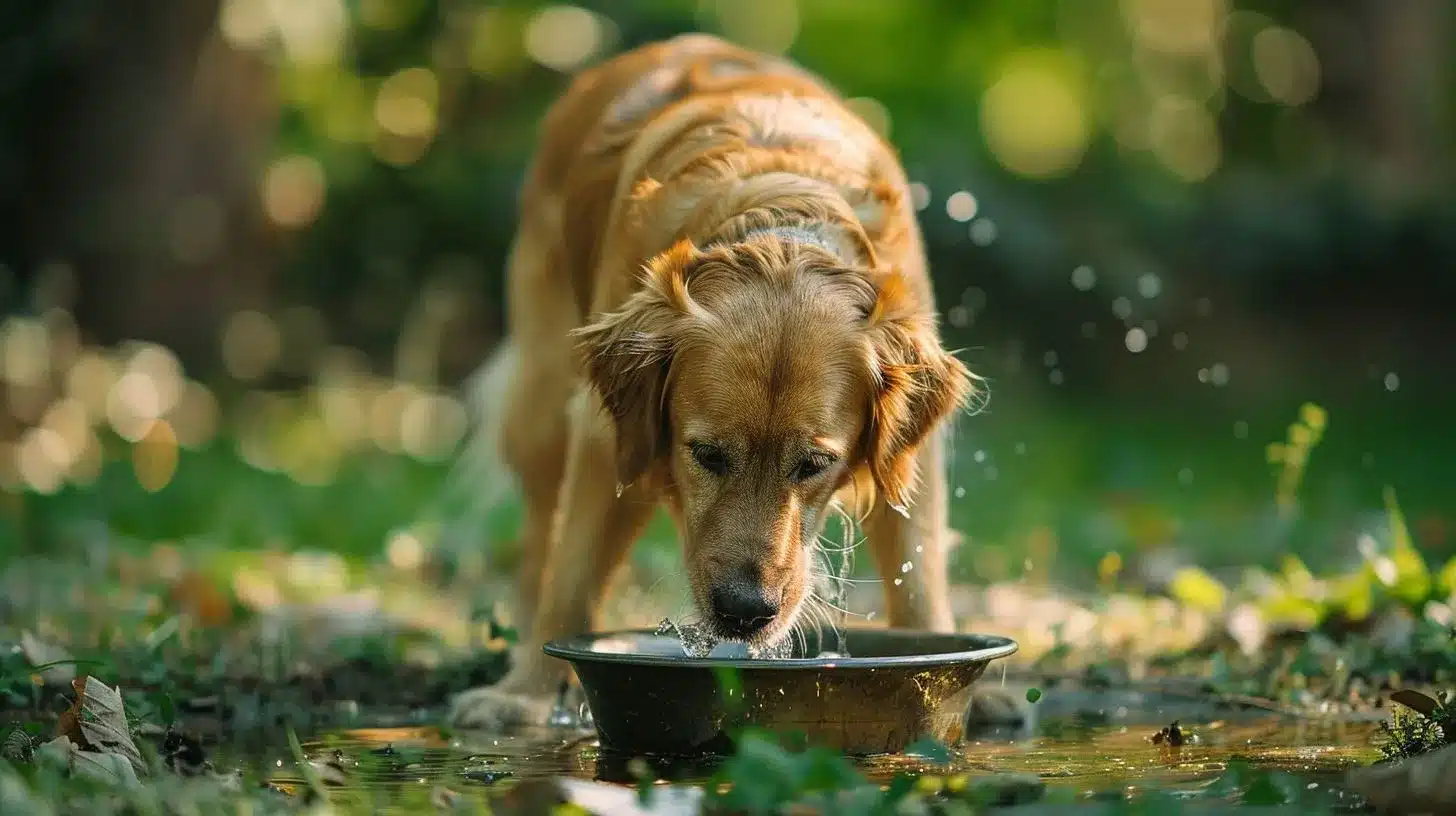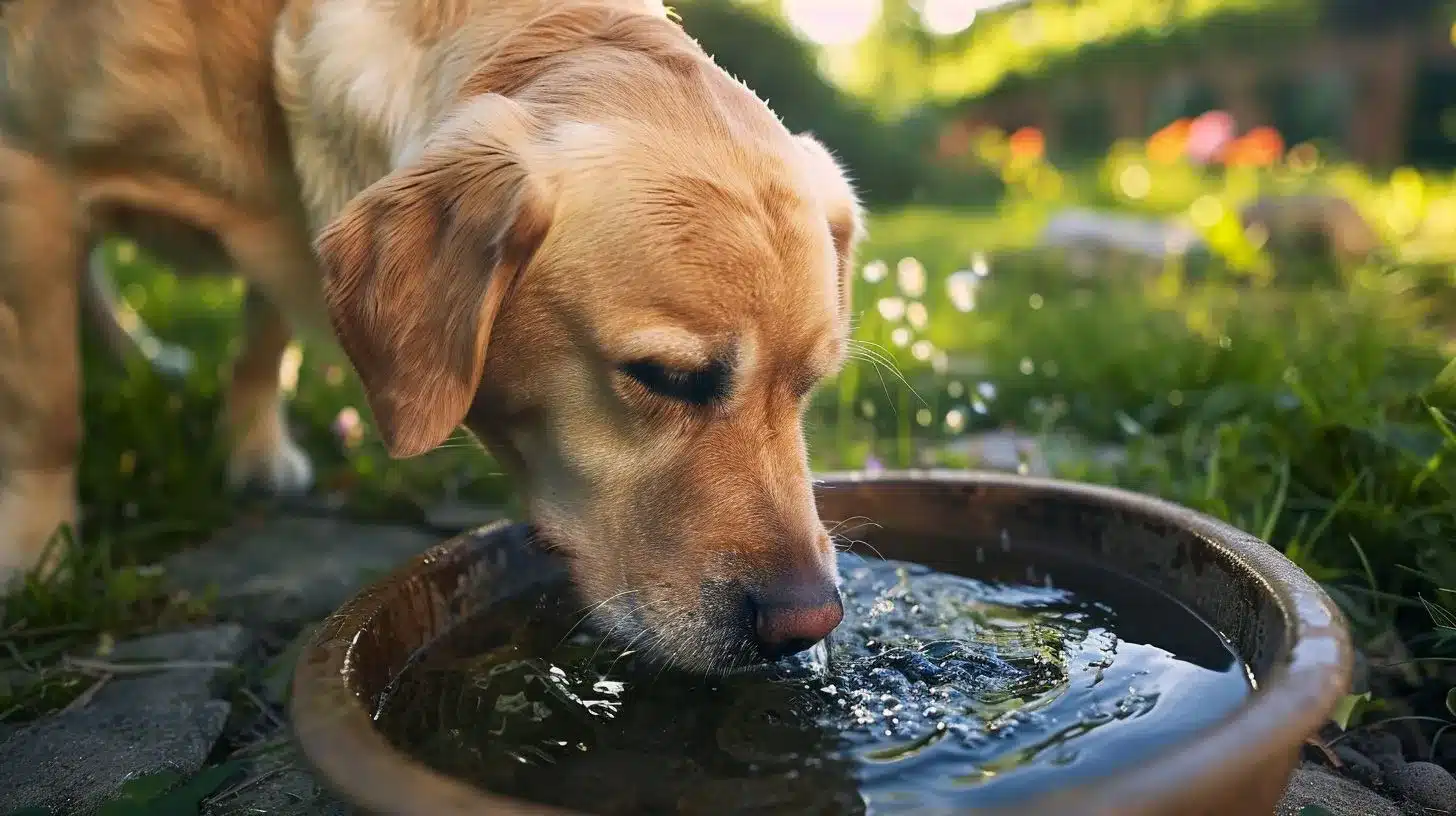Blog The Importance Of Hydration: How Much Water Does Your Dog Need?
Figuring out how much hydration your dog needs to stay healthy and vibrant is an important job for owners.
The general guideline says that a dog should drink approximately 1 ounce of water per pound of body weight daily. Staying properly hydrated is crucial for your dog’s health. Here is how to ensure your dog gets its daily water quota.
Key Takeaways
- Dogs need approximately one ounce of water per pound of their body weight each day to stay properly hydrated and support healthy bodily functions.
- Signs that your dog may not be getting enough water include dry gums, stickiness in the mouth, lethargy, excessive panting, and a decrease in skin elasticity when pinched.
- It’s important to adjust your dog’s water intake based on age, size, activity level, and environmental conditions to ensure they get the hydration they need.
- Regularly monitoring your dog’s water consumption can help identify any sudden changes that could signal underlying health issues requiring veterinary attention.
- Keeping water bowls clean and ensuring easy access to fresh drinking water are critical steps in promoting effective hydration for dogs.
Need help with your dog? Contact Very Important Paws today
The Importance of a Dog’s Water Intake
Ensuring your dog stays hydrated is essential for overall health and well-being. Water is the main component of a dog’s body, regulating its temperature, aiding in digestion, and supporting nerve and muscle function.
Monitoring your dog’s water intake, providing access to fresh water at all times, and adjusting their intake based on age, size, and activity level are crucial to maintaining proper hydration.
Signs of dehydration in dogs include increased thirst, dry nose, pale gums, or excessive panting. Your dog’s water consumption changes should be addressed promptly to prevent severe dehydration or potential health issues.

Why is Water Essential for Dogs’ Body Temperature?
Like ours, water is a dog’s body’s main component of healthy cells. This crucial liquid plays a key role in regulating body temperature, ensuring nerve and muscle function, and keeping joints lubricated for smooth movement.
Dogs should drink about one ounce of water per pound they weigh every day to stay hydrated. This amount supports their overall health and helps prevent organ failure and severe dehydration.
Proper hydration allows a dog’s kidneys to filter waste efficiently from their blood, maintaining optimal bodily functions. Water is essential because it keeps dogs hydrated and supports critical bodily functions that keep them running and playing.

For puppies who burn energy at high rates or larger breeds with more body mass needing more water, staying adequately hydrated ensures they can regulate body temperature effectively on hot days or during intense activity.
Keeping sufficient fresh water available for our furry friends prevents dehydration symptoms such as excessive panting, dry gums, or lethargy. As pet parents in Palm Beach looking into services like hotels or boarding for our pets, understanding the importance of hydration guides us in choosing facilities that prioritize access to clean water daily.
How Much Water Should a Dog Drink Daily
Knowing the right amount of water for your furry friend is key to their health. Dogs should drink about one ounce of water per pound they weigh every day. This means a 20-pound dog needs at least 20 ounces of water daily.
But remember, if your dog is larger or more active, it will need even more water to stay hydrated.
We all understand the role of good nutrition in our dogs’ lives, but keeping them well-watered is just as vital. Whether it’s a hot day in Palm Beach or your puppy has been running around during training at dog boarding, making sure they get enough to drink is essential.
Keep their water bowl filled with clean drinking water and watch for signs they’re getting what they need to keep those tail wags coming!
Signs of Dehydration in Dogs
After discussing how much water dogs need, it’s crucial to spot the signs that a furry friend might not get enough. One clear sign is that if your dog’s gums feel sticky or dry, they’re not well-hydrated.
Another warning signal is if their skin doesn’t snap back quickly when gently pinched between your fingers, showing a lack of elasticity due to dehydration.
Dogs also show other symptoms like panting more than usual, having a dry nose, and appearing lethargic or less lively. If you notice these changes in your pet, especially after a warm day or heightened activity without adequate water intake, they might be dehydrated.
Possible Reasons for Excessive Thirst
Excessive thirst in dogs may signal underlying health issues like kidney disease or diabetes. Other reasons for increased water consumption include medication side effects, heat exposure, and high-sodium diets.
Additionally, older dogs might experience excessive thirst due to age-related conditions like hormonal imbalances or organ dysfunction. It’s important to be vigilant of your dog’s water intake and consult a veterinarian if you notice any sudden changes.
Don’t jump to conclusions about the causes of excessive thirst in dogs. Monitoring their water consumption and seeking guidance from a trusted vet are important steps in maintaining their overall well-being.

Ensuring Your Dog Stays Hydrated
Monitor your dog’s water consumption and adjust it according to age, size, and activity level. Keep their water bowls clean and accessible at all times. Providing fresh water is crucial for your dog’s health and well-being.
Continue reading to learn more about ensuring your dog stays appropriately hydrated!
Providing Access to Fresh Water at All Times
At Very Important Paws, we ensure fresh water is always available to our furry guests. This crucial element supports their overall health, hydration, and bodily functions. Providing easy access to clean and fresh water, we help dogs stay hydrated throughout the day, preventing dehydration and promoting their well-being.
Additionally, we regularly monitor the water bowls to ensure cleanliness and hygiene for our furry friends.
With sufficient access to fresh water, dogs can effectively regulate body temperature and maintain essential electrolyte balance. Very Important Paws understands the significance of this basic yet vital need for our canine guests, so we always provide clean drinking water tailored to their size and activity level.

Adjusting Water Intake for Age, Size, Body Weight, and Activity
Ensuring your dog receives the right amount of water is crucial for their health and well-being. Here are some important points to consider when adjusting your dog’s water intake based on their age, size, and activity level:
- Puppies: Younger dogs are more active and may need more water than adult dogs due to their higher energy levels. Giving them frequent access to clean, fresh water throughout the day is important.
- Small Breeds: Smaller dogs have faster metabolisms than larger breeds and may need more water relative to their body weight. Ensure they have access to enough water based on their size.
- Large Breeds: Dogs with bigger body masses generally require increased water intake to support their larger size and higher energy needs.

- Senior Dogs: Older dogs may have reduced activity levels and lower metabolic rates but need adequate hydration. Monitor their water intake and adjust as needed based on any changes in health or activity.
- Active Dogs: Canine athletes or highly active dogs may require additional water to replace fluid loss from increased sweat during exercise or play.
- Environmental Factors: Hot weather, dry climates, or indoor heating can all contribute to a dog’s dehydration risk, so it’s important to account for these conditions when regulating your pet’s hydration.
By considering these factors, you can ensure that your furry friend stays well-hydrated at all times, promoting optimal health and vitality for years to come.
Monitoring and Addressing any Changes in Water Consumption
Ensuring your dog stays properly hydrated is crucial for their overall health. Very Important Paws always monitor the dogs’ water intake and seek veterinary guidance if we notice any significant changes. Below are some important steps that can help in monitoring and addressing any changes in water consumption:
- Keep track of your dog’s daily water intake, noting any unusual increases or decreases.
- Look out for signs of dehydration, such as dry gums, sunken eyes, lethargy, or loss of appetite.
- Be mindful of excessive thirst or urination, which could indicate an underlying health issue.
- Monitor water bowl levels throughout the day to gauge your dog’s drinking habits.
- Seek professional advice if you notice drastic changes in your dog’s water consumption.

Keeping Water Bowls Clean and Free of Bacteria
Keeping their water bowls clean and bacteria-free ensures our furry friends stay healthy and hydrated. Regularly washing the water bowls with hot, soapy water helps prevent the buildup of harmful germs that could make them sick.
Additionally, using stainless steel or ceramic bowls instead of plastic can reduce the risk of bacterial contamination and is easier to clean thoroughly. This small but vital step is significant in maintaining our pets’ well-being.
It also provides an environment where harmful microbes cannot thrive, safeguarding canine hydration by ensuring access to clean and safe drinking water at all times. Meticulously maintaining these essential tools for hydration can help prevent potential health issues related to contaminated water sources.
Helping a Dog With Difficulty Drinking Water
As dog caregivers, we understand the importance of ensuring that older dogs or those with disabilities can stay hydrated. Here are some helpful tips to assist them in drinking water:
- Elevate the water bowl to a comfortable height for easier access.
- Offer wet food or add water to dry food to increase water intake.
- Use a pet fountain with flowing water to encourage drinking.
- Try offering ice cubes or frozen treats made from low-sodium broth.

Conclusion
Proper hydration is crucial for keeping our furry friends healthy. Dogs need about one ounce of water for every pound they weigh, which varies depending on their size, age, and activity level.
By providing access to fresh water at all times, adjusting intake according to their needs, and monitoring any changes in consumption, we can ensure our dogs stay adequately hydrated.
Observing signs of dehydration and addressing excessive thirst promptly will help prevent potential health issues related to inadequate hydration. Remember that balanced nutrition and sufficient water intake are essential for a dog’s well-being.
FAQs
1. How much water does a healthy dog need every day?
Most dogs need about one ounce of water per pound of body weight daily to stay hydrated and healthy. Larger dogs with more mass will drink more than smaller ones.
2. Why is keeping my dog hydrated so important?
Keeping your dog hydrated helps them regulate their body temperature, lubricate joints, and support proper vital organ functions. It’s crucial for preventing health issues like kidney failure.
3. Can the food my dog eats affect its hydration levels?
Absolutely! Dogs on a diet consisting mainly of canned food containing a lot of moisture may not drink as much water as those on dry kibble diets. Monitoring your pet’s water intake is essential to ensure they get enough.
4. What signs signal dehydration in dogs?
If you notice your dog has dry gums or sunken eyes, or the skin between their shoulder blades doesn’t snap back quickly when pinched, these could signal dehydration. These symptoms require immediate attention to prevent further complications.
5. Is it possible for a dog to drink too much water?
Yes, while rare, drinking too much water can lead to water intoxication in dogs, which disrupts essential electrolyte balance and can be life-threatening if not treated promptly.
6. How do I make sure my dehydrated dog gets enough fluids?
Firstly, serve fresh, clean water throughout the day and encourage them to drink by placing multiple bowls around your home. If you suspect your dog is seriously dehydrated or showing severe symptoms like lethargy or vomiting after drinking too much water quickly consult a veterinarian since these conditions could spiral into a vicious cycle without professional intervention.
Contact Very Important Paws today in Palm Beach for all your dog boarding, hotel, daycare, grooming, and training needs.

